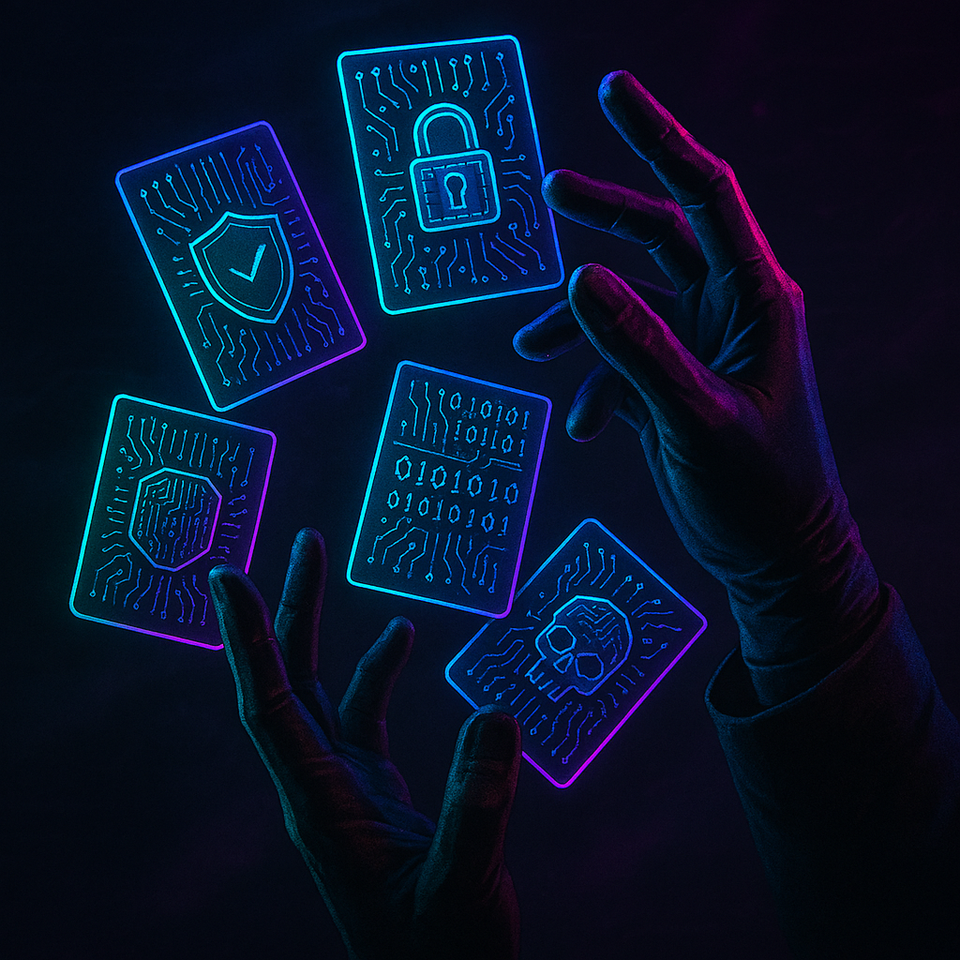Privacy vs Security? No More Shortcuts, AI Defense: The Next Phase, Very Intelligent Rodents, Legitimate Bait, and Tightening the Rules. It's CISO Intelligence for Wednesday, 8th October 2025.
The great 'priorities' struggle, no more skirting the rules, digital wargaming? Little tools with big ears, the right side of temptation, and laying down the law.

Table of Contents
- Client-Side Scanning: The Dark Side of Security?
- Microsoft Blocks More Tricks to Skip Microsoft Account Setup in Windows 11
- When AI Meets Breach and Attack Simulation: The Future is Nigh or Just a Mirage?
- When Mouse Clicks Meet Eavesdropping: The Secretive Mic-E-Mouse Debacle
- Google's AI Bug Bounty: A Goldmine for Sleuthy Coders
- The Art of Third-Party Risk: It's a Jungle Out There!
Client-Side Scanning: The Dark Side of Security?
If there's one thing your grandma didn't quite understand about the internet, it's that privacy wasn't just about closing the curtains... until now.
What You Need to Know
Germany is facing a proposal for client-side scanning of all messages for CSAM (Child Sexual Abuse Material) prior to encryption. This proposal raises significant concerns about privacy and national security, as malicious actors could exploit these scanning systems. Executives are advised to consider the implications on user trust and data security, while strategizing ways to protect communication privacy amid legislative pressures.
CISO Focus: Privacy and Data Security
Sentiment: Strong Negative
Time to Impact: Short (3-18 months)
Germany is currently grappling with a legislative proposal that would require all digital messages to undergo client-side scanning for child sexual abuse material before encryption. Dubbed by critics as a "mass surveillance measure," this initiative has already drawn sharp rebukes from privacy advocates and tech industry leaders who argue it threatens the very essence of privacy and confidentiality in communication.
Monitored messages would undermine the foundation of secure communication—end-to-end encryption. This perspective is staunchly defended by Meredith Whittaker, Signal's President, who sees the proposal as a direct attack on digital security. "You cannot create a backdoor that only lets the 'good guys' in," Whittaker warned, addressing the infeasibility of distinguishing between legitimate surveillance and potential misuse by malefactors.
The Privacy Predicament
End-to-end encryption is esteemed as a cornerstone of modern digital confidentiality, essential for protecting sensitive information across personal, corporate, and governmental communications. This encryption model is now at a crossroads with proposed surveillance methods that would weaken such robust privacy measures.
Critics assert that the German proposal effectively opens Pandora's box, rendering all communications susceptible to unauthorized access. The resultant scenario is one where not just children, but journalists, government officials, and the public-at-large, find their communications intruded upon, thereby eroding trust in digital platforms.
Tech Industry's Rallying Call
Signal and a coalition of privacy advocates have championed an open letter to the German government, urging reconsideration. The letter warns that weakening encryption will compromise digital trust and introduce new vulnerabilities for both state and criminal exploitation. The potential fallout could be dire, affecting everything from personal privacy to national security.
In greater context, the proposal in Germany is emblematic of wider global debates on privacy vs. security, where many nations attempt to balance protecting citizens with upholding liberties. Importantly, the tech community collectively emphasizes that backdoors compromise all security, not merely the privacy of any single user or entity.
The Overarching Threats
The crux of the issue lies in the potential for abuse stemming from client-side scans. By opening up all encrypted messages for scrutiny, malicious actors are gifted a toolkit for invasion. From cyber criminals to state-sponsored hackers, the risks multiply, exposing vulnerabilities everywhere—from confidential state communications to corporate negotiations.
For companies reliant on digital platforms, and governments entrusted with safeguarding sensitive data, the proposal could spell unprecedented risks. Data breaches or leaks arising from such enforced surveillance could jeopardize national security and individual safety.
While the proposal aims to combat child exploitation, it paradoxically undermines the very security platforms that protect societal freedoms. The tech sector, along with civil liberty advocates, must now rally to ensure privacy remains a priority in the digital age, advocating for solutions that address security demands without corroding foundational freedoms.
Vendor Diligence Questions
- What measures do you have in place to ensure the security of data under client-side scanning protocols?
- How does your platform safeguard against unauthorized access if mandated surveillance tools are implemented?
- Can you provide case studies where privacy was maintained without recourse to backdoor solutions?
Action Plan
- Review and Assess: Conduct a thorough impact assessment of the proposed scanning on organizational data flows.
- Policy Update: Revise internal policies to align with best practices for privacy preservation compliant with or resistant to potential legislative changes.
- Stakeholder Engagement: Engage with key industry stakeholders and legal experts to develop a coalition advocating for privacy-preserving policies.
- Educate and Advocate: Raise awareness within your organization and among users about privacy rights and implications of client-side scanning.
Source: Cybernews.com
Microsoft Blocks More Tricks to Skip Microsoft Account Setup in Windows 11
Relax, it's just another hoop to jump through before you can binge on your latest Netflix obsession.
What You Need to Know
Microsoft has stepped up its game by blocking more shortcuts users have traditionally used to dodge Microsoft Account (MSA) setup during Windows 11 installation. This enhancement aims to bolster security measures by ensuring users are adequately logged into MS ecosystem services from the get-go. Executives need to prepare for potential disruptions, especially in environments where user account setup has relied on bypassing these requirements. It's crucial to ensure all systems are updated and that staff are trained on the new requirements to prevent downtime during device provisioning.
CISO Focus: Identity and Access Management
Sentiment: Neutral
Time to Impact: Immediate
In a digital era pushing for pervasive connectivity, Microsoft's latest move to fortify Windows 11 setup requirements is less of a surprise and more of another notch in its security belt. The tech giant has recently plugged holes in its installation process, disallowing users from skipping the setup of a Microsoft Account—a strategy which partially removes some autonomy but reinforces crucial security measures.
Raising the Bar on Setup
-
Microsoft Account Requirement: Initially rolled out with Windows 11, the MSA requirement has stirred both comfort and controversy. While some users appreciate the seamless integration with Microsoft's suite of services, others see it as an unnecessary hurdle—especially in scenarios demanding local accounts for privacy reasons or IT department processes.
-
Blocked Workarounds: Historically, tech-savvy users found it easy to circumvent this requirement using offline account options or networking tricks. This included tactics like using placeholder information or urgently bypassing connectivity setups to force local account creation. Now, those avenues are gradually closing as Microsoft catches wind of such methods.
Implications for Business and Personal Users
-
Business Environment: For companies, particularly those operating in regulated industries, the inability to bypass MSA could mean re-evaluating onboarding processes and digital account management. There might be an initial sting to efficiency; however, consistent access to cloud services, automatic updates, and synchronized profiles could aid long-term productivity and security.
-
Home Users: While everyday users might feel entrapped by this requirement—especially those wishing to keep their local PCs unlinked from the cloud—the benefits to security and integration could outweigh the initial inconvenience. It's a subtle nudge from Microsoft encouraging users to stay sharp about security hygiene.
Navigating the New Norm
As Windows 11 evolves, organizations and individual users must adjust to these mandatory MS account integrations:
-
Smooth Transitions: Proactive measures such as updating IT protocols and training programs for employees will ease the transition. Providing troubleshooting resources and real-time support to guide staff through this new process will minimize disruptions.
-
Data Synchronization: With an MSA, users can sync settings and preferences across devices effortlessly—a boon for productivity but somewhat a bane for those reluctant to share personal information online.
Behind Microsoft's Playbook
Why is Microsoft reinforcing these prerequisites? Simply put, an MSA centralizes user data, enhancing security and service delivery. By mandating this link at the point of installation, Microsoft nudges users towards a tighter security posture. The Live-in-Microsoft approach promises reduced malware risks and improved service through customized experiences.
The latent control over user experience consolidates Microsoft's ecosystem, effectively funneling users through its cloud-centric operating landscape. Critics argue that such moves peel back user autonomy; yet, time and again, tech juggernauts nudge users towards the inevitable marriage of convenience and security.
Outlook: A Pleasantly Cloudier Future?
As users navigate these changes, Microsoft's steadfast approach raises questions about where individual control ends and corporate influence begins. By plugging in early and deeply, users may face a few hitches before settling into a more secure, integrated cloud-ordained rhythm.
And remember: Every update is a ticket further into the cloud—and there's no going back to just local.
Vendor Diligence Questions
- How does the requirement for a Microsoft Account setup impact our current identity and access management strategies?
- Can Microsoft provide a roadmap or timeline for further changes expected in Windows 11 installations that might affect our user account management policies?
- How does Microsoft intend to balance account security with user privacy preferences, specifically with local account needs?
Action Plan
- Review and Update Protocols: Ensure that the IT department updates installation protocols to incorporate the new MSA requirement.
- Training Programs: Implement staff training sessions to familiarize them with the updated setup process.
- Contingency Solutions: Develop alternative solutions for scenarios where bypassing might still be essential (while complying with Microsoft's usage terms).
Source: Microsoft kills more Microsoft Account bypasses in Windows 11
When AI Meets Breach and Attack Simulation: The Future is Nigh or Just a Mirage?
When computers start role-playing as cyber villains, even George R.R. Martin is impressed.
What You Need to Know
Executives at the company need to understand that the landscape of cyber security validation is rapidly evolving with the integration of AI technologies into breach and attack simulation (BAS) tools. These advancements promise a more robust and realistic approach to testing and securing organizational defenses against emerging threats. Immediate investment in these technologies is advised to maintain a competitive edge in cybersecurity resilience.
CISO Focus: Artificial Intelligence in Cyber Defense
Sentiment: Positive
Time to Impact: Immediate to Short (3-18 months)
Reinventing Cybersecurity: A.I. Takes the Stage
In the ever-evolving realm of cybersecurity, staying one step ahead of potential threats is paramount. With data breaches becoming more sophisticated, organizations are in a constant race to outpace cyber adversaries. Enter AI-powered breach and attack simulation (BAS), a game-changer that's reshaping how security validation is perceived and executed.
The Rise of AI in Cyber Defense
Artificial Intelligence has found its way into myriad sectors, but its integration into BAS tools could arguably be one of its most impactful applications yet. BAS platforms traditionally operate by simulating real-world cyber attacks to assess the robustness of an organization's security posture. With AI infused into these systems, simulations become more dynamic, intelligent, and reflective of the complex threat landscape.
AI-enhanced BAS tools are "learning" systems that continually update scenarios. They help pinpoint vulnerabilities that a static tool might miss, capturing the unpredictable nature of human attackers by leveraging vast data sets and machine learning algorithms. This leap forward enables organizations to switch from a reactive to a proactive cybersecurity stance.
What Organizations Stand to Gain
-
Realistic Threat Simulation: AI-powered BAS models create bespoke attack scenarios that are far more nuanced than traditional simulations. This realism is crucial in preparing for genuine cyber threats.
-
Continuous Security Testing: Unlike intermittent penetration testing, AI-driven BAS systems can operate continuously, providing real-time insights as new threats emerge.
-
Cost Efficiency: By automating simulation processes, these tools reduce the need for extensive manual testing, translating to lower operational costs for companies.
-
Improved Incident Response: With more accurate attack simulations, security teams can better train their incident response strategies, ensuring rapid and effective reactions to real breaches.
Challenges Along the Way
While promising, adopting AI in BAS is not without its challenges. Organizations must consider the initial expense of deploying these sophisticated systems. Furthermore, reliance on AI requires a robust IT infrastructure and skilled professionals who can interpret AI outputs effectively.
Privacy concerns also linger, particularly about the data sets used to train AI models. Companies need foolproof measures to ensure clients' and employees' information is protected.
The Future of Cybersecurity Validation
The infusion of AI into breach and attack simulations positions organizations to stay ahead of the curve as cyber threats continue to evolve. According to a report by Cybersecurity Ventures, the cost of global cybercrime will hit $10.5 trillion annually by 2025, pushing the need for advanced BAS tools to the forefront (Cybersecurity Ventures, 2023).
Approaches will likely move toward even greater integration of machine learning, developing systems that not only simulate attacks but also suggest tailored defenses in an increasingly sophisticated manner.
A Punchline to Ponder:
Who needs a crystal ball when you've got AI-powered simulations? The future of cybersecurity sure looks more like the Terminator than a fortune cookie.
Vendor Diligence Questions
- What specific AI technologies are being employed in your BAS tool, and how do they enhance simulation realism?
- Can you provide evidence or case studies demonstrating the effectiveness of your AI-powered simulations in identifying vulnerabilities?
- How is data privacy maintained when using data sets to train AI models within your system?
Action Plan
- Assess Current Tools: Compare current BAS tools with AI-powered alternatives to identify gaps in security validation.
- Budget Allocation: Set aside funds for purchasing or upgrading to AI-powered BAS systems.
- Training and Development: Initiate training programs for IT staff focusing on AI tool utilization and output analysis.
- Vendor Evaluation: Use the provided diligence questions to vet potential BAS vendors.
Source: Redefining Security Validation with AI-Powered Breach and Attack Simulation. Available at: https://www.bleepingcomputer.com/news/security/redefining-security-validation-with-ai-powered-breach-and-attack-simulation/
When Mouse Clicks Meet Eavesdropping: The Secretive Mic-E-Mouse Debacle
"You thought that mouse was just tracking your clicks—turns out, it's plotting to spill your secrets too."
What You Need to Know
The recent discovery of the 'Mic-E-Mouse' vulnerability by researchers at the University of California, Irvine, exposes a hidden risk whereby computer mice can be exploited to capture conversations. This novel side-channel attack uses the precision of high-performance mouse sensors to detect sound vibrations, transforming these into comprehensible audio data. Executives need to understand the immediate need to re-evaluate the cyber hygiene measures to mitigate this threat, specifically concerning physical and device security protocols. Immediate discussion and re-prioritization of cybersecurity efforts around peripheral device vulnerabilities are crucial.
CISO Focus: Device and Peripheral Security
Sentiment: Strong Negative
Time to Impact: Immediate
A surprising new threat underscores just how precarious digital security remains in our hyper-connected world. Researchers from the University of California, Irvine, have unveiled a side-channel attack named Mic-E-Mouse, which can leverage the intricacies of high-performance computer mice as covert listening devices. This vulnerability taps into the very core of everyday device interactions, transforming seemingly innocuous peripherals into potential portals for espionage.
The Heart of the Vulnerability
-
Beyond Simple Functionality:
At its core, the Mic-E-Mouse attack is based on a deceptively simple mechanism. Modern computer mice are equipped with ultra-sensitive sensors, often exceeding 20,000 DPI, for precise tracking. These sensors can inadvertently pick up on the tiny desk vibrations caused by sound waves from nearby conversations, thereby capturing these sounds as mouse movement data. -
Signal Processing Wizardry:
According to the research published in a study on arXiv by Habib Fakih and his team, the seemingly random movement data can be converted into clear audio through advanced signal processing and machine learning. With these methods, the raw data's noise is filtered, piecing together discernible speech from the vibration-captured movements, and boasts surprising efficacy with accuracy up to 61%.
New Frontiers in Eavesdropping
-
Stealth Over Software:
The insidious efficiency of Mic-E-Mouse is that the attack does not require robust malware or invasive software into systems. Instead, any medium capable of accessing the high-speed movement data, such as gaming software, can be utilized to harvest this information. Remarkably, the entire data reconstruction occurs externally, unnoticed by the end-user. -
Implications for Privacy:
This discovery prompts an urgent reevaluation of endpoint security, with implications for individuals and organizations alike. Refreshingly simple yet profoundly invasive, the Mic-E-Mouse exemplifies the need for robust safeguard strategies encompassing all facets of digital and physical security.
Countermeasures: Reinforcing Digital Fortresses
To counter this newly surfaced vulnerability, organizations must adopt comprehensive strategies.
-
Physical Security Protocols:
Reinforce physical security measures in sensitive areas. Sound mitigating solutions, such as desk pads or quiet spaces, could help thwart the capture of sound vibrations. -
Software Enhancements:
Strengthen software and IT protocols to detect unusual data flows from peripheral devices. -
User Awareness Campaigns:
Educate users about peripheral vulnerabilities and promote vigilance over unexpected software interactions.
This Mic-E-Mouse revelation is a stark reminder of how unassuming hardware can become potent vectors for cyber exploits. As cybersecurity landscapes continue to evolve, the need for vigilance over even the most basic digital interfaces has never been more palpable. Careful and constant scrutiny of every endpoint is the key to circumventing such existential threats.
Vendor Diligence
- Question 1: Does your product include any measures to prevent side-channel attacks such as sound-induced data capture from peripheral devices?
- Question 2: Have detailed security assessments been conducted on peripheral data transmission channels?
- Question 3: Can your software monitor unexpected activity in data flow from connected devices?**
Action Plan
-
Risk Assessment:
Execute a detailed review of all peripheral devices within organizational infrastructure for potential vulnerabilities. -
Policy Update:
Revise current cybersecurity protocols to address enhanced endpoint and device security. -
Training Sessions:
Conduct mandatory employee training focused on the risks posed by peripheral devices and how to identify suspicious activity. -
Technology Audit:
Perform regular audits on technology environments to identify possible loopholes in device and network security. -
Vendor Engagement:
Collaborate with device manufacturers to understand the latest security protocols integrated into peripheral devices.
Source: https://hackread.com/mic-e-mouse-attack-computer-mice-conversations/
Google's AI Bug Bounty: A Goldmine for Sleuthy Coders
There's gold in them thar' AI hills, so bounty hunters, saddle up and let the bug busting begin!
What You Need to Know
In an enterprising bid by Google, a new AI bug bounty program is now offering rewards as juicy as $30,000 for anyone who can snare vulnerabilities in their ambitious AI projects. This endeavor reflects Google's commitment to preemptively securing its AI frameworks against cyber threats, which executive management teams should note as a strategic step to bolster AI security and integrity. Technological advancement in AI is a race against time and threats, and board members are expected to recognize the importance of such security initiatives, promoting similar diligence within their own organizations.
CISO Focus: Application Security, Artificial Intelligence, Threat Management
Sentiment: Positive
Time to Impact: Short (3-18 months)
In a rapidly digitizing world, AI isn't just transforming industries but also opening up new vistas of vulnerabilities. Startlingly aware of this emerging threat landscape, Google is shifting gears to boost its AI's shield, spectacularly unveiling a Bug Hunters program with rewards of up to $30,000. The focus: vulnerabilities in Google’s growing palette of AI tools. As echoes of 'bug bounty' ripple through cyberspace, cybersecurity professionals and ethical hackers are now flocking to this tech treasure hunt, fueling a wave of innovative security strategies.
Why AI Now?
The question echoing among tech leaders isn't "why AI security?" but "why not sooner?" AI has breached into everyday life, from predicting consumer behavior to even shaping policy-making. Google, an AI torchbearer, understands this constantly evolving realm must be safeguarded with meticulous precision. It is an acknowledgment that AI not only enhances user experience but also carries latent risks that can escalate into serious threats. By announcing a significant monetary reward, Google has spun a web for talented bug hunters to catch potential flaws before they can be exploited maliciously.
How Does It Work?
Participants are invited to inspect AI systems underpinning Google’s diverse applications. The pecuniary prize varies based on the itchiness of the vulnerability: eye-roll inducing bugs might net lesser amounts, while grave lapses in security integrity can fetch up to the top mark. This hierarchy ensures attention isn't just blanketly distributed but is keenly focused on axial vulnerabilities that could have widespread impacts. The scheme echoes an understanding that safeguarding AI is an inclusive community effort, where diverse insights are not just valuable but necessary.
Industry Implications
Google's model demonstrates a scalable precedent, where companies fortify their digital backbone through inclusive security frameworks. As AI algorithms become more integral to various sectors, industries might undertake similar bounty initiatives or entirely novel security measures. Engaging ethical hackers and security scholars can transform potential threats into collaborative learning experiences.
The Bounty Buzz
Whether one calls it a financial carrot or a calculated incentive, the buzz is real. By actively involving a community of global security enthusiasts, Google isn't only mitigating risks but is compounding its reputation as a forward-thinking giant. The immediate implications resonate with organizations dependent on AI, spurring an introspective view of their security stamina.
And remember, while Google’s initiative is captivating, it’s also a call-to-arms for looking at security not as a Band-Aid but as a deeply embedded business strategy.
The Bug's Last Laugh
Does this mean all AI-related woes are solved with a few bountiful checks? Hardly. But the tactical gesture reaffirms that security evolves alongside the technology it shields. The undertone of progression and optimism in Google’s announcement is a glimpse into a future where AI and security aren’t dichotomous but are intertwined components of development.
Vendor Diligence Questions
1 c. How does the vendor plan to mitigate AI-specific security vulnerabilities?
2. What is their history with employing bug bounty programs, and how successful have they been?
3. How are the findings from the bounty program integrated back into the product development lifecycle?
Action Plan
Immediate Steps for CISO Team:
- Perform an immediate review of existing AI frameworks for potential vulnerabilities.
- Encourage participation in Google's bug bounty programs to gain insights.
- Host a knowledge-sharing session on AI security vulnerabilities identified in similar programs.
Mid-term initiatives:
- Roll out internal incentives similar to bug bounty programs for security findings.
- Engage with cross-industry panels to exchange insights on AI threat mitigation.
Long-term Goals:
- Integrate a comprehensive AI threat model into the organizational risk assessment strategy.
- Develop a continuous AI integrity education program for all tech-related staff.
Source: Google's new AI bug bounty program pays up to $30,000 for flaws
The Art of Third-Party Risk: It's a Jungle Out There!
If trusting third parties were a sport, we’d all need better referees.
What You Need to Know
With cybersecurity breaches increasingly occurring through third-party vendors, establishing a robust Third-Party Risk Management (TPRM) policy is crucial for safeguarding an organization’s data and reputation. Executives are advised to assess current TPRM frameworks, ensure they align with comprehensive guidelines, and integrate them into broader risk management strategies.
CISO Focus: Third-Party Risk Management
Sentiment: Strong Positive
Time to Impact: Immediate
Organizational reliance on third-party vendors is inevitable, transforming the risk landscape into a multi-layered conundrum. An effective Third-Party Risk Management (TPRM) policy acts as a safeguard against these potential threats, helping companies navigate safely through this complicated ecosystem.
The Importance of Identifying Third-Party Risks
Organizations today partner with a multitude of third parties for various operational processes. Unfortunately, this development brings vulnerabilities. As vendors widen access to internal systems and data, the risk surface expands significantly. According to Ponemon Institute, nearly 60% of organizations have experienced a data breach through third-party vendors in recent years. Thus, identifying third-party risks isn't just necessary—it's imperative.
Elements of an Effective TPRM Policy
A successful TPRM strategy hinges on eight foundational elements that ensure thorough assessment and management of vendor relationships:
-
Program Governance - Establish a governing body to oversee TPRM processes, making sure they align with organizational goals.
-
Risk Assessment - Conduct ongoing assessments to determine the risk levels associated with each vendor. Regular reevaluation ensures that any changes in risk levels are swiftly addressed.
-
Due Diligence - Execute comprehensive due diligence processes before partnership inception, investigating a vendor's security posture.
-
Contractual Standards - Draft rigorous contracts stipulating vendor responsibilities and expectations, including security protocols and incident response requirements.
-
Continuous Monitoring - Establish mechanisms for constant surveillance of third-party activities, allowing prompt detection of non-compliance or emerging risks.
-
Formalized Communication - Set structured communication channels to ensure seamless dialogue between organizations and their third-party vendors.
-
Training and Awareness - Educate internal stakeholders and vendors about TPRM policies, fostering a security-centric culture.
-
Incident Response - Develop a coordinated response plan that includes vendors, ensuring quick resolution of security incidents.
Challenges of Implementing TPRM
Despite its benefits, implementing an effective TPRM policy involves overcoming multiple challenges:
-
Complexity and Cost: Establishing a robust system requires substantial investment in both time and resources. Balancing the cost with the benefits is a hurdle that challenges many organizations.
-
Integrating with Existing Frameworks: Seamlessly integrating TPRM into established security frameworks can be cumbersome, requiring significant coordination between departments.
-
Vendor Resistance: Vendors may resist providing full transparency, complicating efforts to assess their risk posture thoroughly.
Pruning Through the TPRM Jungle
Queensland Health's experience in managing third-party risks serves as a suitable cautionary tale. When the agency encountered a data breach through an outsourced payroll provider, the lack of adequate TPRM highlighted the importance of comprehensive vendor oversight. Queensland Health subsequently augmented its risk management strategies, reinforcing the critical nature of sound TPRM.
Tech-Forward Future: TPRM meets Automation
Leveraging automation tools to monitor vendor risk levels and compliance going forward can simplify the arduous task of managing third-party relationships. Automation not only streamlines processes but functions as an early warning system for potential breaches.
As third-party partnerships continue to burgeon, replacing outdated manual oversight with robust TPRM policies becomes a strategic imperative. Organizations must act swiftly to address this digital era's jungle, lest they find themselves lost in its thickets.
Vendor Diligence Questions
- What is the vendor's history of security breaches, and how have they managed past incidents?
- How does the vendor ensure compliance with relevant industry standards and regulations?
- How does the vendor conduct its internal third-party risk assessments?
Action Plan
- Review Current TPRM Policy: The team should carry out a gap analysis of existing policies against the recommended TPRM elements.
- Vendor Communication Audit: Implement an immediate audit of communication plans and security agreements with current vendors.
- TPRM Awareness Training: Initiate training sessions for both internal stakeholders and key vendor partners to raise awareness of TPRM significance.
- Integration with Automation Tools: Evaluate and incorporate automation technologies to enhance continuous monitoring and threat detection capabilities.
Sources:
- Essential Components of an Effective TPRM Policy | UpGuard
- Ponemon Institute’s Third-Party Data Risk Study
- Case Study on Queensland Health’s Payroll System Breach
CISO Intelligence is lovingly curated from open source intelligence newsfeeds and is aimed at helping cybersecurity professionals be better, no matter what their stage in their career.
We're passionate advocates for good cybersecurity at home, at work, and in government.
Thank you so much for your support!
CISO Intelligence by Jonathan Care is licensed under Creative Commons Attribution-NonCommercial-NoDerivatives 4.0 International




